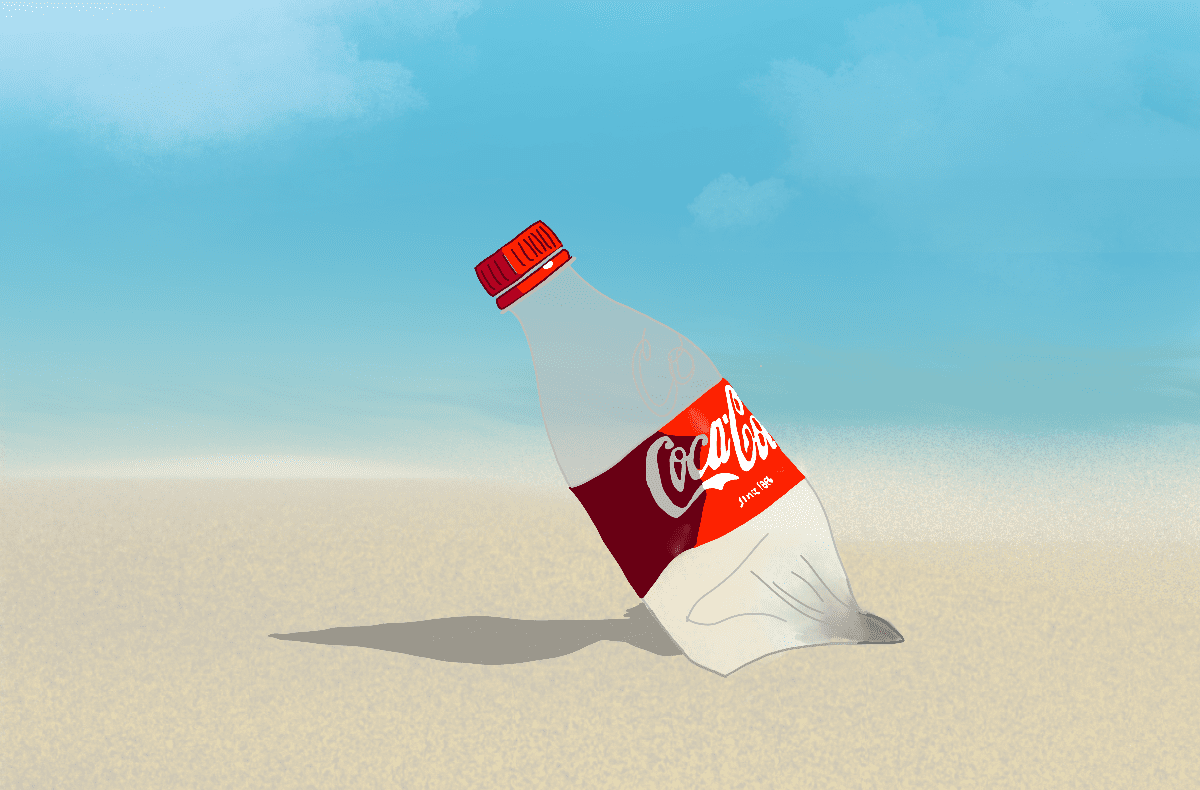
Illustration by Nikki Muller
Plastic: it’s a miracle product when you think about it. You can shape it almost any way you want, it’s cheap to produce, lightweight, and sterile, which is why it’s a staple for the majority of food packaging seen in shops and has revolutionized the medical sector.
By now, we all know plastic has a dark side—it can take up to 500 years to biodegrade, which makes it a huge ecological threat, with plastic rubbish disrupting natural habitats and health-threatening microplastics showing up in drinking water. Despite these issues, it’s very hard for consumers and manufacturers to wean ourselves off this miracle product.
The UK charity Planet Patrol, which promotes litter picking and the recording of collected rubbish, releases their findings annually; in 2021 they found that the top polluters in the UK are as follows:
- Coca-Cola
- McDonald’s
- Cadbury
- Red Bull
- Walkers
- Lucozade
- Stella Artois
- Tesco
- Budweiser
- Strongbow
Topping the list is corporate behemoth Coca-Cola, which is one of the most recognizable brands in the world. Ask for it virtually anywhere, and even if they don’t speak English, people are likely to know what you’re after.
Coca-Cola has been around for over 130 years, long before plastic in food and drink packaging was the norm; this article follows the evolution of coke bottles and cans to plastic. Given that they’re the top source of plastic pollution in the UK, why is the brand so reluctant to go back to their traditional form of packaging in glass bottles and aluminum cans?
Despite increasing concerns about the environmental impact of single-use plastic bottles, Coca-Cola continues to produce and distribute its drinks in plastic bottles. There are a few reasons why this is the case.
Convenience
The major reason why Coca-Cola continues to use plastic bottles is because of its convenience and portability. Plastic bottles are lightweight and easy to carry, which makes them ideal for people on the go. They are also easy to store and can be conveniently placed in car cup holders, backpacks, and gym bags.
Affordability
Another reason Coca-Cola continues to use plastic bottles is its cost-effectiveness. Plastic bottles are cheaper to produce and transport than alternative packaging options, such as glass bottles or cans. This allows Coca-Cola to keep its prices competitive, which is particularly important in markets where there is a lot of competition.
Durability
Another point is that plastic bottles are generally more resilient than other packaging types, they are also more reliable. They can be dropped, or knocked over and still maintain their seal, protecting their content from contamination, in contrast to glass bottles, or cans which can be punctured, or dented.
Admittedly, Coca-Cola has made steps to lessen the environmental impact of its bottles. It has committed to using more recycled plastic in them, and has also set a goal to recover and recycle the equivalent of 100% of its packaging by 2030. Additionally, it has launched several initiatives, such as recycling programs, designing bottles from plant-based materials, or improving the recyclability of its packaging. But clearly, these measures have not been enough to move the company off—or at least down—Planet Patrol’s top ten list.
How Can We Pressure Coca-Cola To Change?
Several things can be done to tackle Coca-Cola’s plastic problem in the UK—and not all of these are the company’s responsibility:
- Implement a bottle deposit scheme in the UK as soon as possible, since this has been very successful in other countries at reducing plastic pollution and improving recycling of plastic bottles. In Norway, 95% of plastic bottles are recycled, compared to 57% in the UK.
- Waste collectors and local authorities across the UK should have a harmonized approach to plastic. Waste legislation should therefore be standardized and improved, instead of having different guidelines for every local authority. This would simplify collection and recycling rates.
- Everyone should pressure manufacturers such as Coca-Cola to make their bottles from 100% recycled plastic—no more weak excuses should be allowed to stand against the practice, such as consumers being put off by recycled plastic’s off-color tinge.
- Consumers should “vote with their dollars” by buying products in cans and glass bottles, as these can be recycled safely over and over.
Many things can be done to tackle plastic pollution, and big plastic producers such as Coca-Cola have a huge part to play in accepting responsibility for the amount of waste they produce. They should stop lobbying the government against laws such as the bottle deposit scheme designed to reduce plastic pollution, and accept that their “business as usual” is not sustainable.
Lastly, and perhaps most importantly, consumers need to change as well. To empower companies and governments to make necessary changes, we need to put our collective support behind it. This means we need to change our attitude towards food and drink packaging, and make a conscious effort to purchase sustainably. If we continue to value convenience and affordability over the health and future of our planet, we will wind up paying the heaviest price. Ultimately, getting the force of public opinion on board with more sustainable packaging is what will drive the likes of Coca-Cola to change.
